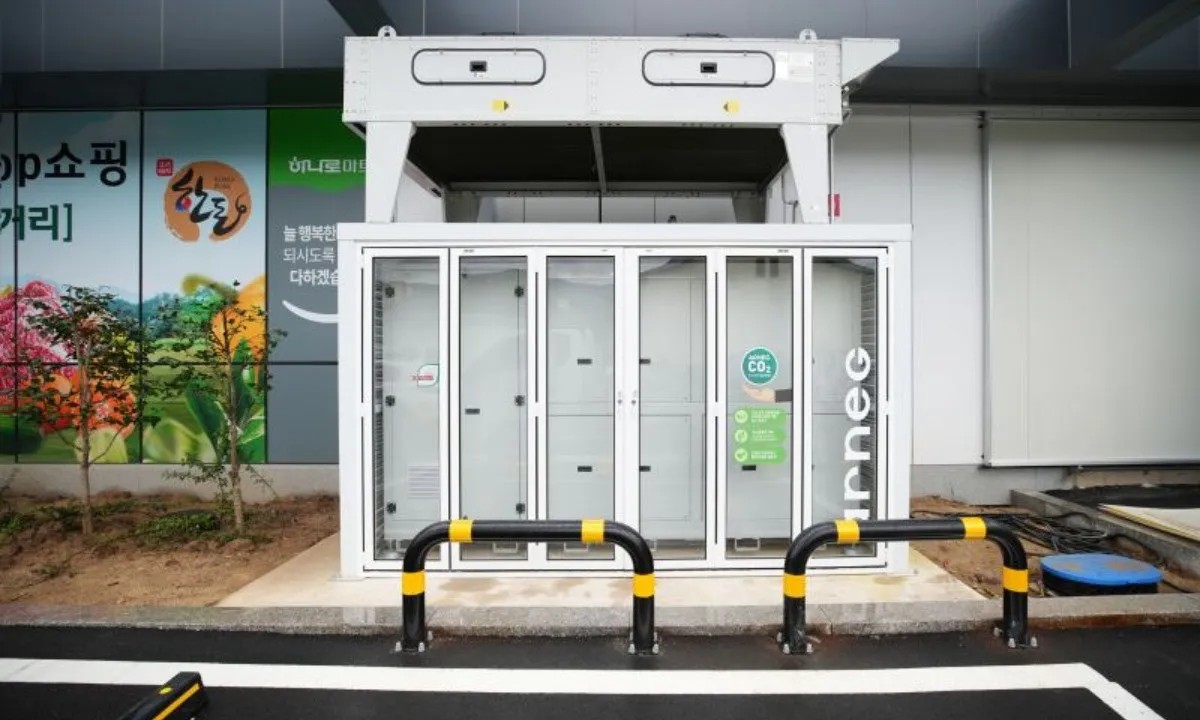South Korea’s ‘first-ever’ transcritical CO2 supermarket saves 57% on its annual electricity bill vs. store using R404A, says Arneg
April 01, 2024

The “first-ever” South Korean supermarket with a transcritical CO2 (R744) refrigeration system, a Nonghyup Hanaro Mart store in Jangseong-gun, has annual electricity costs that are 57% lower compared to a similar store using R404A, according to a case study conducted by the Korean branch of Italian OEM Arneg.
The 1,375m2 (14,800ft2) Nonghyup Hanaro Mart store ‒ operated by Baekyangsa Nonghyup (National Agricultural Cooperative Federation) ‒ opened last September. Its transcritical CO2 refrigeration system was provided by Arneg, which deemed it the first one ever installed in a South Korean supermarket.
The OEM reports that the system has a COP of 2.68, while a comparable store using R404A has a COP of 1.78.
“The coefficient of performance is 34% higher when you use the CO2 system compared to R404A, which is what the client wants to see,” said Gabriele Sernani, Manager of Overseas Sales at Arneg Korea.
Details of the CO2 refrigeration system’s performance were presented by Sernani at the ATMOsphere APAC Summit 2024, with Kim Seungjae, Executive Director of Baekyangsa Nonghyup, providing the end-user insight.
The event, held February 6–7 in Tokyo, was organized by ATMOsphere, publisher of R744.com.
With a CO2 charge of 63kg (138.9lbs), the rack provides cooling for two medium-temperature (MT) and two low-temperature (LT) cold rooms plus 12 MT cabinets and one LT cabinet. The system has a cooling capacity of 38kW (10.8TR) for its MT applications and 6kW (1.7TR) for its LT cold room and cabinet.
System design parameters include a 130bar (1,886psi) MT discharge pressure and 60bar (870psi) for liquid MT and LT pressure suction, meeting the up-to-38°C (100.4°F) ambient temperature requirements.
Arneg Korea’s case study also indicates that the transcritical CO2 system saves 55.3 metric tons of CO2e emissions annually over a similar store with an R404A system with a refrigerant charge of 71kg (156.5lbs). The OEM said the savings were derived from calculating the direct emissions from refrigerant leakage and indirect emissions from energy consumption.
Energy-saving design
“For energy savings and reliability, the rack uses a parallel compressor [10.2kW/2.9TR], variable-speed devices and a liquid receiver backup unit, with heat recovery providing hot water for the building,” Sernani said. An inverter system, “applied to all the compressors,” provides variable-speed control, with algorithms determining the refrigerant flow rate for “optimal state” partial-load operation.
Using Arneg Korea-designed Eco-Glass doors on all cabinets provided further energy savings. The doors use three panes of Low-E (low-emissivity) glass – which deflects infrared rays – separated with “high-end” insulation spacers.
Conventional refrigeration case doors have a heater on the outside pane to prevent condensation and keep the door from freezing shut. According to Sernani, the Eco-Glass doors, which omit a heater on the outside pane, provide the same food quality and safety benefits as conventional cabinet doors but reduce energy consumption by an additional 65% while offering 7% more product visibility.
“Taking the heater out of the glass reduces the energy consumption of the door to zero,” he added.
Its Eco-Glass doors have become a “huge request” for new and existing showcases in the market, Sernani said.
Evangelizing CO2
When asked why the retailer decided to use a CO2 system, Seungjae said Baekyangsa Nonghyup wanted to establish a new path and be the first in Korea to use natural refrigeration to support environmental, social and governance regulations. For this reason, he contacted Arneg Korea and chose CO2 even though the initial investment cost was more than a typical R404A system.
The success of the CO2 system has led Seungjae to push for the technology to be used in the cooperative’s 2,200 other stores. While a timeline for a full-scale roll out was not given, Seungjae did say a new Nonghyup Hanaro Mart store will be opening soon with a CO2 refrigeration system.
Seungjae remarked that he seeks to educate the public and competitors about the advantages of CO2 refrigeration. “We put the CO2 rack at the store’s main entrance to show people its benefits,” he said.
While Korea does not have a subsidy program for installing natural refrigeration systems, a participant in the audience indicated that a government committee was formed in 2023 to work on a refrigeration subsidy program. “We have a meeting in March with some school associations,” the speaker said. “I will share this energy-saving data, and we will raise our voice to the government, including the Minister of Environment and the Minister of Industry.”
Headquartered in Venice, Arneg operates 21 manufacturing facilities worldwide, offering CO2 refrigeration solutions ranging from 2kW (0.57TR) to over 450kW (128TR). The company also manufactures propane (R290) equipment and ammonia (R717), ammonia/glycol and ammonia/CO2 systems.


